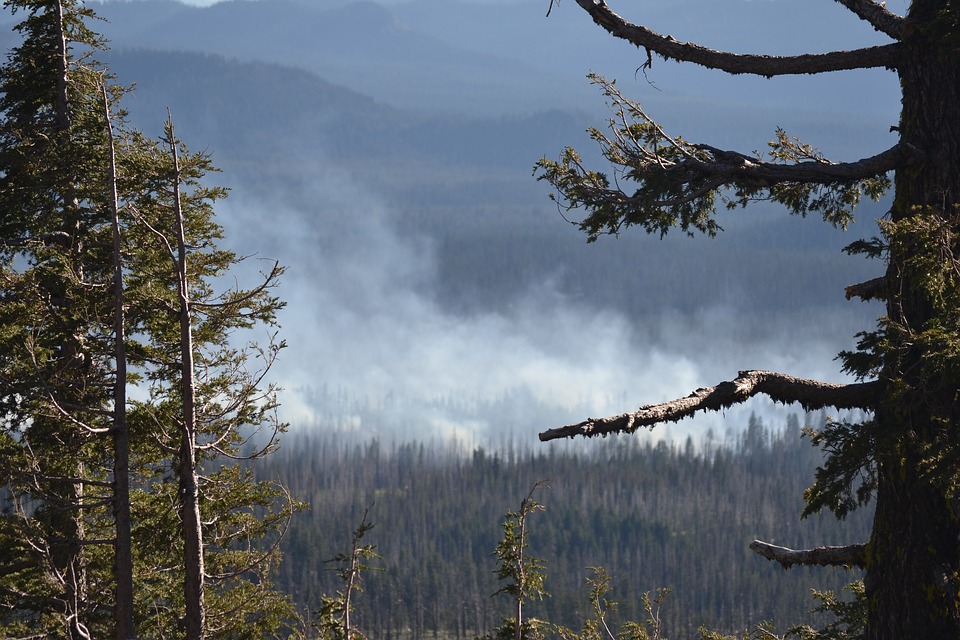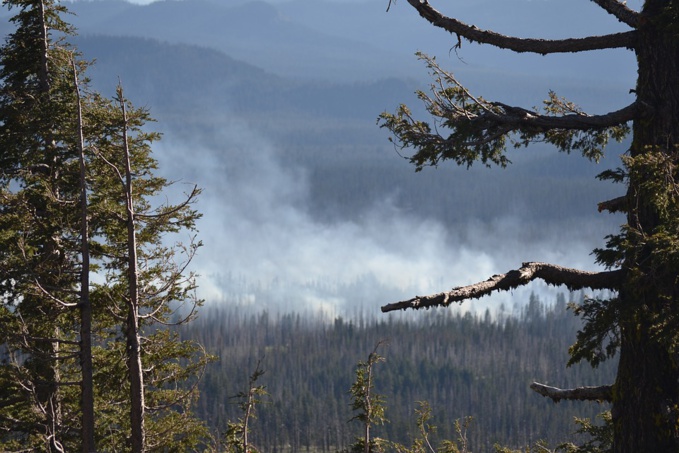25 thousand hectares of forest burnt in Sweden
Forest fires that erupted in 80 different locations in Sweden due to anomalous heat destroyed about 25 thousand hectares of forest. In the summer months, the air temperature in Sweden is on average 23 degrees, but thermometers showed 30 degrees and more for the first time in the country’s history. The drought has broken the 74-year record, and so Sweden is experiencing the hottest summer in the last 66 years. Anomalous heat causes forest fires. The damage from them has reached 600 million Swedish kronor. Thousands of people in the districts of Gävleborg, Jämtland and Dalarna had to leave their homes due to fires.
The hottest summer in 260 years in Stockholm
Meteorological observations in Sweden have been held since 1756. The first temperature record for July was beaten in 1994, when the air warmed to 21.5 degrees. And in July 2018, there was an unprecedented heat wave in the history of the country. Experts predict a further increase in temperature. It is expected that the air temperature will exceed 30 degrees first of all in Stockholm and Uppsala. Among those who suffered the most are farmers who now find it difficult to feed livestock.
A natural disaster declared in Japan
The number of deaths due to the intense heat has reached 65 people last week in Japan. The Japanese Meteorological Agency declared these weather conditions as a natural disaster. The Agency's statement noted that there are unprecedentedly high temperatures in some areas. Such a heat presents a real threat to life. 22 thousand people were hospitalized because of the abnormal heat over the past weeks in Japan. Half of all taken to hospitals are elderly people. Last week in Kumagaya, the air temperature reached 41 degrees, and this is the highest temperature in Japan in the history of observations. In Tokyo, the temperature reached 40 degrees for the first time in the history of the city. So far, nothing indicates that the heat will subside, the Japanese meteorological agency states. The authorities warn that the air temperature will be 35 degrees and above in August. Meanwhile, heavy rains that swept the west and the central part of the country in early July, provoked floods and landslides, as a result of which 80 people were killed, and more than 40 went missing. Population losses due to floods and landslides were recorded in such regions as Hiroshima, Ehime, Okayama, Yamaguchi, Kyoto, Gifu, Shiga, Hyogo, Kochi and Fukuoka. 5.9 millions were ordered or recommended to be evacuated in 19 regions of the country affected by showers.
Fires in Greece
Not only the forest fires that erupted in Eastern Attica in Greece turned thousands of square meters of forest plots into ashes, but also have killed at least 74 people to this very moment. The fire, which began for unknown reasons in the forest zone in the Mati area, where hotels and tourist sites are located, soon spread to residential areas.
Powerful showers in Istanbul
Showers in Istanbul are also one of the consequences of climate change. Turkey is among those who will suffer the most due to the climate changes. Most of them will affect such regions as the Mediterranean basin and the territories near the Sea of Marmara. Today, the level of landscaping of the center of Istanbul is 3-4%. And this leads to the fact that the rain immediately forms violent streams and provokes a flood. Experts note that in the near future, climate change can turn into sudden torrential rains, anomalous heat, abnormal cold and an abnormal drought. This will undoubtedly be accompanied by new natural phenomena, the consequences of which we cannot predict.
330 natural disasters
AON's report on weather, climate and natural disasters estimates that at least 330 different natural disasters occurred in the world in 2017. The geographical distribution of economic losses from these events is as follows:
- Hurricane Harvey and adverse weather conditions in America - about $ 100 billion;
- Hurricanes Maria and Irma in the Caribbean islands - about $ 120 billion;
- Forest fires in America – about $13 billion;
- Floods and typhoon Hato in China - about $ 15.5 billion;
- Drought in Southern Europe - about $ 6.6 billion;
- Earthquake in Mexico - about $ 4.5 billion;
- Forest fires in Portugal and South Africa - about € 250 million.
We exceeded the norm earlier… again
Recently, the Global Foodprint Network has announced a new record: the resources that the Earth can reproduce over the year were spent in 212 days. The statement noted that the World Environment Day will be shifted for two days ahead and falls on August 1 this year. And this means that people consume resources such as carbon, food, water, soil, wood in destructive volumes.
source: dunya.com
Forest fires that erupted in 80 different locations in Sweden due to anomalous heat destroyed about 25 thousand hectares of forest. In the summer months, the air temperature in Sweden is on average 23 degrees, but thermometers showed 30 degrees and more for the first time in the country’s history. The drought has broken the 74-year record, and so Sweden is experiencing the hottest summer in the last 66 years. Anomalous heat causes forest fires. The damage from them has reached 600 million Swedish kronor. Thousands of people in the districts of Gävleborg, Jämtland and Dalarna had to leave their homes due to fires.
The hottest summer in 260 years in Stockholm
Meteorological observations in Sweden have been held since 1756. The first temperature record for July was beaten in 1994, when the air warmed to 21.5 degrees. And in July 2018, there was an unprecedented heat wave in the history of the country. Experts predict a further increase in temperature. It is expected that the air temperature will exceed 30 degrees first of all in Stockholm and Uppsala. Among those who suffered the most are farmers who now find it difficult to feed livestock.
A natural disaster declared in Japan
The number of deaths due to the intense heat has reached 65 people last week in Japan. The Japanese Meteorological Agency declared these weather conditions as a natural disaster. The Agency's statement noted that there are unprecedentedly high temperatures in some areas. Such a heat presents a real threat to life. 22 thousand people were hospitalized because of the abnormal heat over the past weeks in Japan. Half of all taken to hospitals are elderly people. Last week in Kumagaya, the air temperature reached 41 degrees, and this is the highest temperature in Japan in the history of observations. In Tokyo, the temperature reached 40 degrees for the first time in the history of the city. So far, nothing indicates that the heat will subside, the Japanese meteorological agency states. The authorities warn that the air temperature will be 35 degrees and above in August. Meanwhile, heavy rains that swept the west and the central part of the country in early July, provoked floods and landslides, as a result of which 80 people were killed, and more than 40 went missing. Population losses due to floods and landslides were recorded in such regions as Hiroshima, Ehime, Okayama, Yamaguchi, Kyoto, Gifu, Shiga, Hyogo, Kochi and Fukuoka. 5.9 millions were ordered or recommended to be evacuated in 19 regions of the country affected by showers.
Fires in Greece
Not only the forest fires that erupted in Eastern Attica in Greece turned thousands of square meters of forest plots into ashes, but also have killed at least 74 people to this very moment. The fire, which began for unknown reasons in the forest zone in the Mati area, where hotels and tourist sites are located, soon spread to residential areas.
Powerful showers in Istanbul
Showers in Istanbul are also one of the consequences of climate change. Turkey is among those who will suffer the most due to the climate changes. Most of them will affect such regions as the Mediterranean basin and the territories near the Sea of Marmara. Today, the level of landscaping of the center of Istanbul is 3-4%. And this leads to the fact that the rain immediately forms violent streams and provokes a flood. Experts note that in the near future, climate change can turn into sudden torrential rains, anomalous heat, abnormal cold and an abnormal drought. This will undoubtedly be accompanied by new natural phenomena, the consequences of which we cannot predict.
330 natural disasters
AON's report on weather, climate and natural disasters estimates that at least 330 different natural disasters occurred in the world in 2017. The geographical distribution of economic losses from these events is as follows:
- Hurricane Harvey and adverse weather conditions in America - about $ 100 billion;
- Hurricanes Maria and Irma in the Caribbean islands - about $ 120 billion;
- Forest fires in America – about $13 billion;
- Floods and typhoon Hato in China - about $ 15.5 billion;
- Drought in Southern Europe - about $ 6.6 billion;
- Earthquake in Mexico - about $ 4.5 billion;
- Forest fires in Portugal and South Africa - about € 250 million.
We exceeded the norm earlier… again
Recently, the Global Foodprint Network has announced a new record: the resources that the Earth can reproduce over the year were spent in 212 days. The statement noted that the World Environment Day will be shifted for two days ahead and falls on August 1 this year. And this means that people consume resources such as carbon, food, water, soil, wood in destructive volumes.
source: dunya.com



















